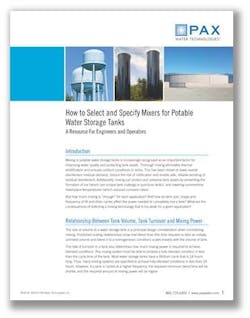How to Select and Specify Mixers for Potable Water Storage Tanks
Mixing in potable water storage tanks is increasingly recognized as an important factor for improving water quality and protecting tank assets. Thorough mixing eliminates thermal stratification and ensures uniform conditions in tanks. This has been shown to lower overall disinfectant residual demand, reduce the risk of nitrification and enable safe, reliable boosting of residual disinfectant. Additionally, mixing can protect and preserve tank assets by preventing the formation of ice (which can scrape tank coatings or puncture tanks) and lowering summertime headspace temperatures (which reduces corrosion rates). But how much mixing is “enough” for each application? And how do tank size, shape and frequency of fill and drain cycles affect the power needed to completely mix a tank? What are the consequences of selecting a mixing technology that is too weak for a given application?
